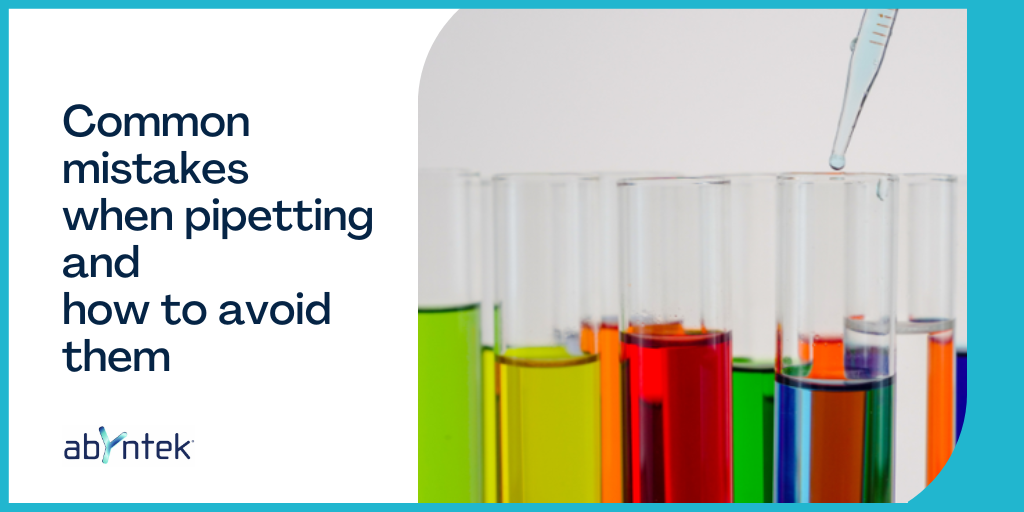Pipettes are essential instruments for accurately measuring and dispensing reagents. But that precision is of little use if the measurements are not made exactly. Certain common mistakes when pipetting can directly affect that accuracy and hamper the reproducibility of the assays.
In this post, we tell you what are those common mistakes when pipetting and how we can avoid them.
At Abyntek Biopharma we are experts in reagents for scientific research. If you have questions about how to carry out your experiment, ask our experts to advise you throughout the process.
Mistake #1: not assessing the viscosity of the sample
It is important to note the physical properties of the sample, as these directly affect the volume dispensed. In the case of dense samples containing large and viscous molecules, they tend to stick to the tip surface, dispensing more slowly. In contrast, samples containing ethanol, for example, being less viscous and more volatile, will be dispensed more quickly and will tend to evaporate.
Some of the ways to minimize these effects are through the use of ultra-low retention pipet-tips, which contain a hydrophobic plastic additive that prevents liquid from sticking to the inside of the tip, or through reverse pipetting.

Mistake #2: DISPENSING LIQUID REAGENTS TOO FAST
Pipetting too quickly increases the probability of making mistakes in dispensing the correct volumes, as well as favouring contamination of the pipettes, among other things.
MISTAKE #3: PIPETTING DIFFERENT SAMPLES WITH THE SAME TIP
If the same tip is used to extract and dispense a sample and then immediately pipet another sample without changing it, sample contamination may be induced.
MISTAKE #4: failing to perform proper pipette maintenance
Pipettes can lead to error in measuring volumes or cause contamination if not maintained correctly.
Daily cleaning with 70% ethanol is essential, as well as the use of different pipettes for general tests and for more specific tests such as those that require RNAse-free environments.
MISTAKE #5: NOT CALIBRATING THE PIPETTES WITHIN THE ESTABLISHED DEADLINES
It is recommended to calibrate the pipettes at least once a year, an ideally every 3 months, to ensure that the measurements made with them are accurate.
MISTAKE #6: PIPETTING FROM THE WRONG ANGLE
The correct angles for pipetting are 90º to aspirate and 45º to dispense.
MISTAKE #7: ASPIRATE AIR
Although it may seem simple, it is a common mistake that must be paid attention to, since in addition to pipetting an inaccurate volume, when aspirating air, the liquid can enter the neck of the pipette.
Mistake #8: EXCESSIVELY immerse the pipette tip when aspirating the sample
The liquid should be aspirated from the surface of the sample, taking care not to aspirate air. For reference, 1-5 ml pipets should be inserted 5-6 mm below the meniscus, while smaller volume pipettes should be inserted only 2-3 mm.

MISTAKE #9: STORE PIPETTES IN A HORIZONTAL POSITION
Pipettes should be stored in an upright position, preferably in stands specially designed for them. In this way, liquids that may have entered the neck of the pipette are prevented from escalating and causing contamination and/or corrosion phenomena.
MISTAKE #10: NOT USING THE RIGHT TIPS
Another common mistake when pipetting is to no take into account the size of the tips, that must be adapted to each specific pipette to ensure the precision and accuracy of the measurements, and to avoid contamination. If the tips do not fit correctly, air can scape when you aspirate and dispense the liquid sample, leading to inaccurate results.
MISTAKE #11: NOT MOISTENING THE TIPS PREVIOUSLY
Dipping the tips increases the moisture within the tips, thus minimising solution evaporation. This practice is usually recommended for volumes greater than 10µL.
MISTAKE #12: FAILING TO TAKE INTO ACCOUNT THE ROOM TEMPERATURE AND /OR THE TEMPERATURE OF THE SAMPLE
Pipette calibration is usually done at room temperature, so if you work at significantly lower or higher temperatures, the measurement will not be accurate. Sample temperatures can also cause dispensed volumes to vary.
mistake #13: APplying the pipetting technique incorrectly
The main rules for correct pipetting can be summarized as:
- Pipetting slowly and gently.
- Keep the pipette upright when aspirating the sample.
- Dip tip slightly into sample when aspirating.
- Dispense the liquid on the side well or on the liquid at 45 º angle.
Do not hesitate to contact us and we will advise you on the reagent that best suits your research.




